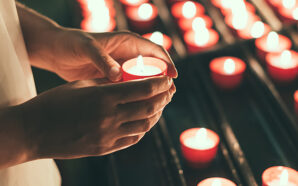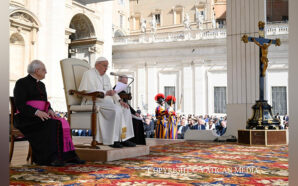Most Reverend Vincent Long Van Nguyen OFM Conv DD STL, Bishop of Parramatta
Address to the National Association of Deacons Conference 2019, Fremantle
“The renewed ministry of diakonia in the Church beyond the shadows of the priesthood“
4 October 2019
INTRODUCTION
I’d like to thank you all for giving this opportunity to reflect with you on the role of deacons and its future in the Church in Australia.
Even though I am an expert neither in the history nor the theology of the diaconate, I believe that the time has come for a deeper appreciation and application of this ministry within the larger context of a diaconal Church.
I am proud to say that our diocese is now home to one of the most diverse and dynamic groups of permanent deacons in Australia. They are drawn from vastly different backgrounds and greatly enrich the life of the local Church.
I am convinced that this is the sign of the times when Christian ministries are increasingly reimagined and revitalised by way of relational maturity, mutuality, collaboration and service rather than privilege, elitism and individualism that have often been the baggage of the clericalist priesthood.
We celibate clergy have a lot to learn from you and your spouses as you seek to embody the ideal of Christian service in your public ministry and marriage covenants.
DIACONATE IN THE EARLY CHURCH
There is a Church ministry of deacon that goes back to the time of the apostles, even though its exact point of origin cannot be determined. This ministry was taken very seriously as attested by the New Testament. The life of a deacon was portrayed as truly Christian life, i.e., the model of the deacon is Christ the servant. The Church has continually seen the deacon as an integral or even essential part of its ministerial structure.
Deacons gained prominence in the early Church as evidenced by St Laurence and St Ephraim. Many were in charge of the treasury and some became bishops and even popes. Problematic relations between priests and deacons in the Roman Church gave rise to the so-called “cursus honorum” by which no one could begin the steps towards the priesthood unless he was qualified.
The importance of the diaconate waned as a result of the shift towards the celibate priesthood as the normative form of ministry. Deacons were seen as either exceptions to the norm for priesthood or stepping-stones to it. Throughout the second millennium, to speak of ordination was to speak ultimately about the priesthood.
It was only at the Second Vatican Council that the priesthood of the faithful was recovered and the diaconate was restored as a sacramental order distinct from the presbyterate.
RESTORATION OF THE DIACONATE
One of the major achievements of the Second Vatican Council was the restructuring of the sacrament of orders. Along with the suppression of the minor orders, the Council restored the diaconate and defined its function in communion with the presbyterate and the episcopacy.
Paragraph 29 of Vatican II’s Dogmatic Constitution on the Church contains the ancient assertion that deacons “receive the imposition of hands not unto priesthood but unto service. For strengthened by sacramental grace they are dedicated to the People of God, in conjunction with the bishop and his body of priests, in service of the liturgy, of the Word, and works of charity.”
The decision to restore the Order of the Diaconate was not driven by bishops from developing nations. Rather, it came most forcefully from bishops in Europe who had experienced the impact of the Second World War and the desire to meet the pastoral needs that arose in its aftermath.
In addition to sacramental and liturgical functions, the bishops also envisaged the need for deacons to exercise the administration of the Church’s temporal goods. They spoke of the many charisms, distinct from the priesthood, which were established to provide direct assistance to the bishop in the care of the poor and the nurturing of the community.
Thus, Paragraph 16 on the Missionary Activity of the Church, the sacramental grace of the diaconate is spoken of as follows: “For there are men who actually carry out the functions of the deacon’s office, either preaching the word of God as catechists, or presiding over scattered Christian communities in the name of the pastor and the bishop, or practicing charity in social or relief work. It is only right to strengthen them by the imposition of hands which has come down from the Apostles, and to bind them more closely to the altar, that they may carry out their ministry more effectively because of the sacramental grace of the diaconate.”
This statement affirms the unique charism of the diaconate, that is to say, it no longer finds its sacramental end in the priesthood as has been the case for centuries. The diaconate would emerge from the shadows of the presbyterate and become its own permanent state of life.
DIACONATE AS EMBODIMENT OF THE CHURCH’S DIAKONIA
At Vatican II, the predominant rationale for restoring the permanent diaconate was that following the horrors of war and violence, the Church needed a new form of ordained ministry that was modelled on Christ the Humble Servant.
Pope Paul VI would later declare that the diaconate was the driving force for the Church’s own diakonia. Pope John Paul II likewise taught that the service of the deacon is the Church’s service sacramentalised.
The clerical sexual abuse crisis and the curse of clericalism that contributed to it have awoken in the Church the desire for ordained ministers to manifest the servant leadership of Christ. More than ever, the diaconate becomes the embodiment of the Church’s diakonia, which is fundamental to its nature.
The servant leadership model is much more than what we do to the people. It is indicative of who we are as humble and vulnerable servants in the likeness of Christ who came to serve and to give his own life for others. Hence it is a way of life – a modus vivendi before it can be translated into a way of service – a modus operandi.
We Christian leaders today are more than ever before challenged to embrace the journey of vulnerability and powerlessness, which is at the heart of the Gospel.
So much of what is wrong with the Church today stems from the travesty of Christian leadership and service. As far as I am concerned, the sexual abuse crisis is only the tip of the iceberg. In other words, it is a symptom of a serious malaise, which is invariably described as the cancer of clericalism.
Unless we have the courage to see how far we have drifted from the vision of Jesus, unless we are prepared to go beyond the symptoms and explore the deeper issues that lurk behind the surface, unless we genuinely repent of our sins and face up to the task of reclaiming the innocence and powerlessness of the servant-leader, we will have failed the test of our integrity, discipleship and mission.
When privilege, power and dominance are more evident than love, humility and servanthood in the church, then the very Gospel of the servant Jesus is at stake. What we need to reclaim for the Church forcefully and unequivocally is the notion of diakonia.
To this end, we as leaders need to manifest the diakonia of Christ in who we are and what we do. Until we have reclaimed diakonia, the Church will be less than what Christ intends it to be.
The Church can only be the conduit of compassion and speak the language of hope to a broken humanity when it truly personifies powerlessness and stands where Christ once stood, that is, firmly on the side of the outcast and the most vulnerable.
The restored and revitalised Order of the Diaconate will help restore the crucial aspect of all Christian ministries as an expression of the Church’s diakonia.
If you noticed carefully, Pope Francis was actually wearing a stole like a deacon – and not like a priest- when he performed the ritual of feet washing on Holy Thursday.
I suspect it was an intentional act, a symbol of the Church that is committed to humble service, the Church that expresses diakonia in actions that heal and nurture people and relationships. The spirit of diakonia must characterise the very nature of Christian ministry of leadership and service.
DIACONATE AS EMBODIMENT OF MUTUALITY
I visited Mundelein Seminary in Chicago and I noticed an interesting feature of the Seminary Chapel. There were seven steps leading to the high altar and on the side of each step was written the respective name of one of the seven Holy Orders. Each step would create an ever-growing chasm between the candidate and the people.
It dawned on me that these vestiges of the Tridentine model of priesthood are powerful symbols of the clerical class. It is part of the ecclesiology that emphasises the ontological change and separation of the ordained from the faithful. It is a powerful ingredient and ideal condition for the disease of clericalism to fester.
I hold that it is time for this exalted, elitist and separate model of priestly ministry to be consigned to the past.
Instead, we must rediscover the specific and full charism of the priesthood within the matrix of the universal priesthood of the faithful. The priesthood and Christian ministry generally cannot be lived fully apart from the community of disciples. This is one of the key insights of the Vatican Council.
The one-sided cultic emphasis gave way to a wider apostolic ministry, which has found expression above all in the teaching, sanctifying and shepherding offices of Christ. The diaconate, if it has a chance to flourish, must be freed from the shadow of the cultic priesthood.
There existed a variety of ministries in the early Church. Paul bears witness to this when he lists a number of gifts or charisms that Christ gave to the Church for the building up of His body.
Yet over the centuries, this richness has been gradually concentrated in the ordained at the expense of the baptised. It is time, therefore, that the priesthood needs to break open anew so as to fully honour what Paul says in that same passage in Ephesians 4 “everyone is given grace according to the measure of the gift of Christ”.
This is where the diaconate can act as an antidote to clerical dominance and self-sufficiency. Whereas the celibate and male priesthood in the Catholic Church has an innate tendency towards individualism, the diaconate is often exercised not in isolation but in partnership with others, especially with the spouses. The diaconate embodies the injunction of Jesus that Christian ministries be exercised collaboratively and not in isolation.
When Jesus sent out his disciples to announce the Good News, he did so in pairs. What I derive from that practice of his is that Christians can only minister effectively when they recognise their limits as individual and are open to partnership with others.
If the Christian ministry has a better future, it has to find expression in better mutual support, collaboration and partnership. I would especially emphasise the ability to minister with women, because the Church is much the poorer without the gift of women.
DIACONATE AS EMBODIMENT OF THE CHURCH IN THE WORLD
I am greatly encouraged by the vocations to the permanent diaconate in my diocese. These are men who have transitioned into the second half of their lives and have reached a certain level of relational maturity.
They have also – more often than not – been tested by their lived experience in the world, including in the workplace. It is a phenomenon that the Church is yet to appreciate fully and to maximise its potential for its own benefit.
Their immersion into secularity by way of their professional jobs allows them to actively stand with working people. The expression of faith in daily life in the world is not an extra but is of the essence of Christianity.
It therefore seems right that some clergy should be fully in the strains and stresses of daily life to the extent of earning their living at secular work.
Often with ordination, there can be a certain sense of status, separation and even alienation that sets the ordained from ordinary people. The diaconate with its characteristic closeness to ordinary situations can help bridge the divide and build relationships between the minister and the people through solidarity with them. This is not to say the priest is not able to do the same.
In fact, the worker-priest movement specifically endeavours to immerse its members in the secular world while maintaining their priestly identity. It is however the nature of the diaconate, with its immersion into secularity through ordinary experience of family life and work, which enables the minister (and his spouse) to share more intimately the daily struggle of his people.
CONCLUSION
It is my hope that the deacons and their spouses be empowered to serve according to their gifts and talents. Their role is much more than a liturgical accessory to the bishop or the priest celebrant.
I have already seen a deacon and his wife thrive in their leadership role as Parochial District Pastoral Director. It is quite conceivable, as far as I am concerned, to appoint deacons and their wives as positions of leadership, including pastoral directors of local communities.
Finally, I firmly believe that we are on the threshold of renewal and transformation of the ordained ministry. If the ordained ministry has a better future, it has to find expression in better mutual support, collaboration, partnership and immersion in the coalface reality. It has to free itself from the variant strains of clericalism such as sexism, narcissism and paternalism.
The restored and revitalised diaconate with its characteristic embodiment of the Church in its fundamental expressions of service, mutuality and immersion in secularity has a potential to reset the ordained ministry towards a better future.
Most Rev Vincent Long Van Nguyen OFM Conv
Bishop of Parramatta








